Timeline shows key negotiations that launched Sandia Lab, marked beginning of Labs’ 70-year history
Images courtesy of Sandia National Laboratories
See below: 70 ways Sandia has changed the nation
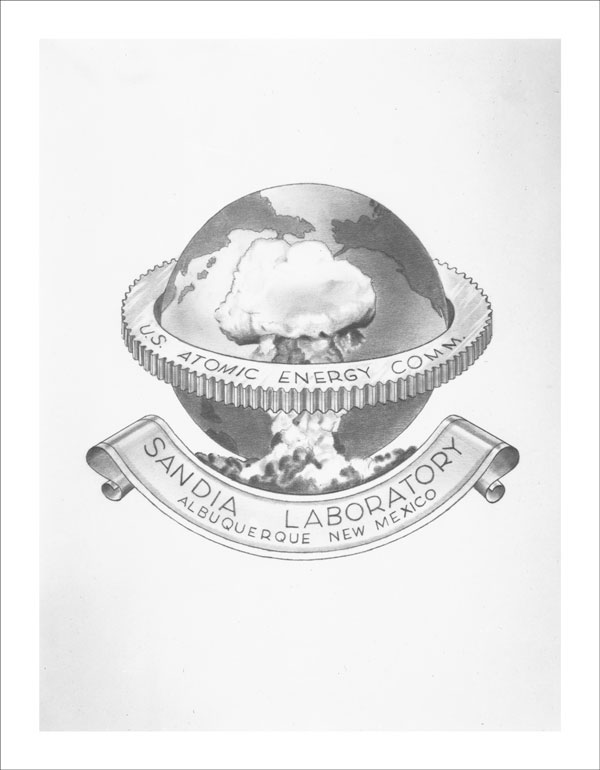
Two dates are well known to Sandians: the day President Harry Truman wrote a letter calling for “exceptional service in the national interest” and the day Sandia (previously Z Division) separated from its parent, Los Alamos National Laboratory, and became the entity we know it as today.
During the six months from May 13 to Nov. 1, 1949, a fair amount of negotiation, hesitation and ambiguity ensued before the management reins of Sandia Laboratory were officially handed over. And in the seven decades that followed, the organization now known as Sandia National Laboratories has made a significant mark on our nation and the world.
Negotiations set Sandia in motion
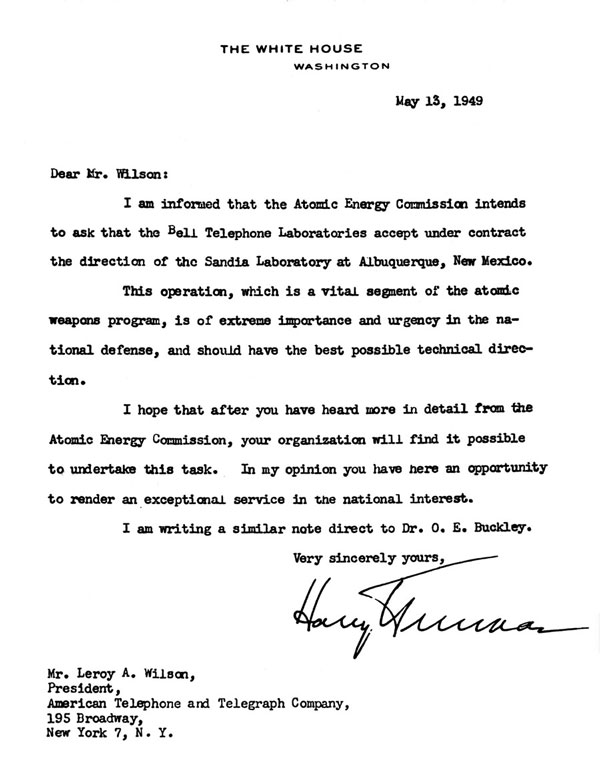
May 10, 1949: Sandia Laboratory was still a branch of Los Alamos Scientific Laboratory when U.S. Atomic Energy Commission Chair David Lilienthal recommended that American Telephone & Telegraph be asked to take on management of the Lab.
May 13, 1949: President Harry Truman wrote an iconic letter to AT&T President Leroy Wilson, informing him of AEC’s intent to ask Bell Telephone Laboratories to manage the Lab. Truman urged Wilson to undertake the task, indicating an opportunity to render “an exceptional service in the national interest,” which is the source of Sandia’s motto.
May 30, 1949: When AEC representatives Chairman David Lilienthal, Carroll Wilson and Division of Military Applications Director General James McCormack visited Leroy Wilson to discuss the contract, he expressed concerns about the then-pending antitrust suit against the Bell System; his preference for a no-profit, no-fee arrangement; and the defense workload to which AT&T was already committed. However, he agreed to consider their request.
July 1, 1949: Wilson formally accepted the contract to operate Sandia on behalf of the Bell System, comprising AT&T, Bell Laboratories and Western Electric. Because Sandia was an engineering lab, Western Electric — the engineering arm of the Bell enterprise — undertook the management role.
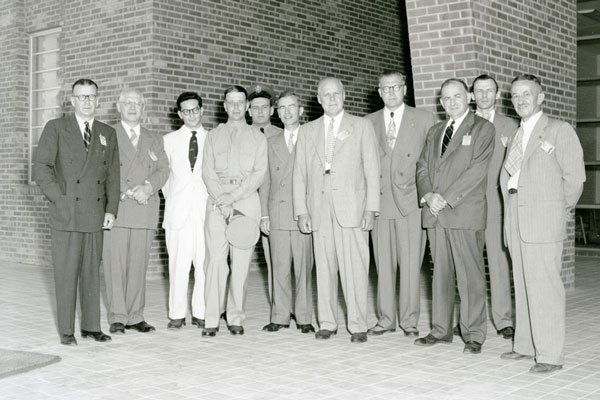
August 29, 1949: On the same day that the USSR detonated its first nuclear device, Captain Carroll Tyler of the AEC, Robert Underhill of the University of California and Fred Lack of Western Electric gathered in Los Alamos to draw up and sign the formal “Takeover Agreement” for Sandia Laboratory. Their goal was a smooth transition to industrial management with minimal disturbance to current operations. A month later, Western Electric executives signed the Certificate of Incorporation that created Sandia Corporation.
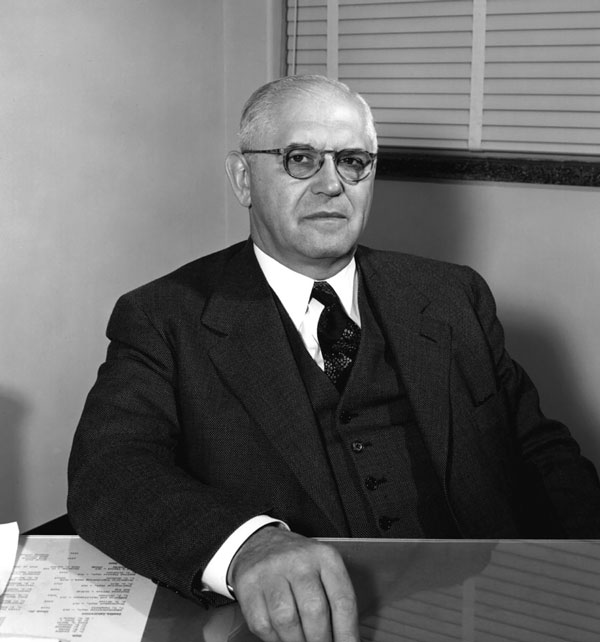
October 6, 1949: During the first Sandia Corporation Board of Directors meeting, the contract between AEC, Sandia Corporation and Western Electric was executed. The Certificate of Incorporation had been filed in Delaware the day before. The first board members were H.C. Beal (VP Manufacturing), Fred Lack (VP Radio Division), Walter L. Brown (VP and General Counsel) and George Landry, all from Western Electric.
November 1, 1949: Sandia became its own entity, and Sandia Corporation (a wholly owned subsidiary of Western Electric) took over management of the Lab for the AEC. George Landry served as the first president of Sandia Corporation and first director of Sandia Laboratory.
Sandia opened the Livermore, California, site in 1956, and Congress officially designated Sandia a DOE national laboratory in 1979. Sandia Corporation became a wholly owned subsidiary of Martin Marietta (later Lockheed Martin Corporation) in 1993. Then, on May 1, 2017, National Technology and Engineering Solutions of Sandia LLC, a wholly owned subsidiary of Honeywell International Inc., assumed management of the Labs.
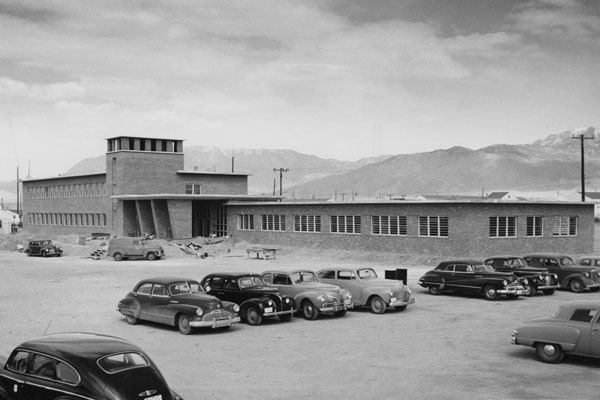
Where we are now
Since that autumn day 70 years ago, 15 directors have led Sandia from a single-mission organization responsible for engineering nonnuclear components of nuclear weapons to a multiprogram organization engaged in a broad spectrum of national security issues.
In 1949, Sandia started with 1,720 people occupying 151,000 square feet of space in Albuquerque. Today, the Labs employs 12,920 people working in 7,088,020 square feet of laboratories, offices and other workspace spanning four states.
For a complete look back at Sandia’s 70-year history, from building a nuclear weapons stockpile to post-Cold War transitions to today’s emphasis on national security, visit Sandia’s history timeline. Employees can also view 70 Years of Sandia: How We Got Here, a special 70th-anniversary presentation on the history of Sandia, available on the internal digital streaming library.
70 ways Sandia has changed the nation
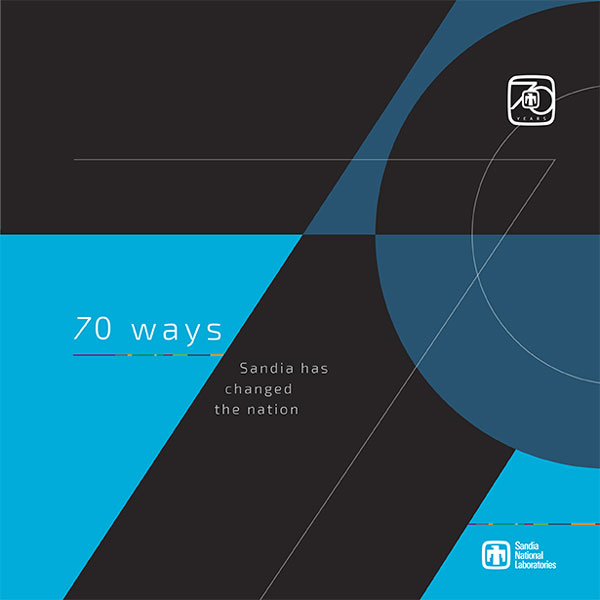
Since 1949, Sandia has developed science-based technologies that support national security. Americans depend on Sandia’s technology to solve national and global threats to peace and freedom.
Inventions like the clean room, polycrystalline diamond compact drill bits, percussion-actuated nonelectric disrupter and rapid medical diagnostic tools have revolutionized industries.
Our experts have been called to investigate and intervene following major accidents involving spacecraft, battleships, offshore drill rigs and nuclear power plants. Advances in nuclear deterrence, antiterrorism, supercomputing, hypersonics and pulsed power have changed the world for the better.
To commemorate the Labs’ 70th anniversary, Sandia has created a website and brochure featuring these and other significant Labs contributions to national security.